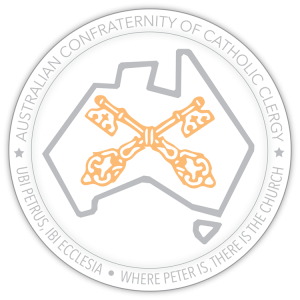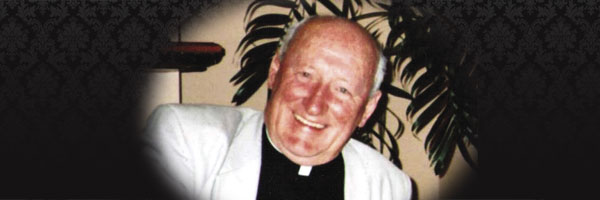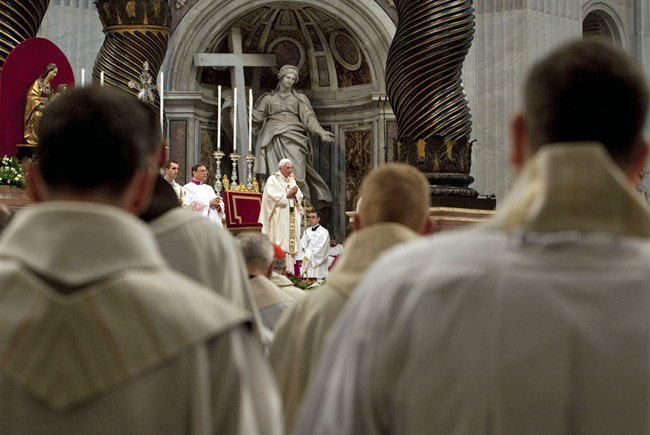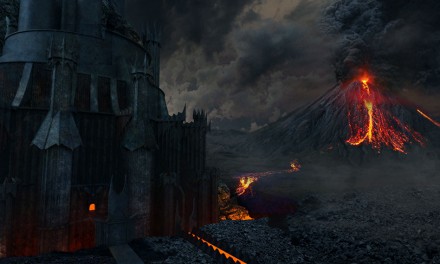The life of Monsignor Francis Lyons
Monsignor Frank (Tiger) Lyons was born in Brunswick on 20th December 1921 and on Sunday, 4 September 2011, just short of his 90th birthday, the angels ‘piped the still’ and he died peacefully at St Joseph’s Home, Northcote Victoria.
He was ordained on 24th July 1949 at St Patrick’s Cathedral, East Melbourne. After several parish appointments he was appointed as a Reserve Chaplain to the Royal Australian Navy in February 1957, and a year later he transferred to the Permanent Naval Force. For twenty one years he served in various ships and establishments. He retired from the Navy as the Principal Catholic Chaplain.
After leaving the Navy he retained a great interest in the Navy and its people. When the Navy was looking for a Catholic Chaplain to serve at HMAS Lonsdale Melbourne, Archbishop Little approached Frank to seek his advice and to identify a priest to fill this position. Needless to say, my former Parish Priest nominated me.
I had the privilege to have known Monsignor Frank Lyons, both as my pastor, as I negotiated my way through seminary formation, and as a brother priest. Over the years, he regaled many a priest with his adventures in the Navy, while maintaining a great love for the Priesthood and the Church. As my Parish Priest and since the seminary was located in his parish, he took an active interest in seminary formation, providing a sanctuary for many a seminarian experiencing the cut and thrust of formation, and the discrepancy between what was being taught at Theological College and the Magisterium of the Church in both doctrine and liturgical practice.
Monsignor Lyons was affectionately known as ‘Tiger’ Lyons, an endearment that may have come about by his willingness to be forthright and to stand his ground when he saw an injustice or when someone was belittling the Church. His manly approach in living out his Priesthood was brought to the fore at HMAS Cerberus, when an officer was loudly making offensive remarks about the Catholic faith. Tiger Lyons invited the officer to step out of the Wardroom; this would allow the Catholic Chaplain to make an ‘officer like’ intervention thus ceasing any further offensive remarks.
This ‘Tiger’ approach was also displayed as Monsignor Lyons became the ACCC Chair. As the ACCC ‘founding fathers’ were vacating the executive positions, Monsignor Lyons stepped into the breach. During his time in the Chair he consolidated the activity of the ACCC by encouraging younger priests to take up positions of responsibilities, as well as voicing the concerns of preists who believed that the NCP did not represent them appropriately at the Australian Catholic Bishops Conference. Under Monsignor Lyons leadership, all representations to the ACBC were made after much prayer, and while others might have wanted a more aggressive advocacy, his representations allowed the particular Bishops’ committee to have room to manoeuvre, while still expressing ACCC particular concerns.
After his stroke and as he became increasingly impaired, he maintained the discipline of daily Mass, praying the rosary, and interested in the Church appointments. Monsignor Lyons was a great defender of the Church’s teaching and the legitimate expression of this teaching.
Monsignor Lyons was the Chaplain onboard HMAS Melbourne on 10th February 1964 when the Navy experienced its greatest peacetime disaster. Just before 9pm as Monsignor Lyons was moving up towards Melbourne’s flight deck HMAS Voyager hit Melbourne, and sank off the south coast of New South Wales.
Seconds after the collision, and once it was suggested that Voyager had been cut in two, Monsignor Lyons immediately ‘raised his right hand and aloud pronounced the words of General Absolution, making the sign of the Cross’. After this he raced back to the quarter deck and started ministering to the ‘young lads dazed and wondering about the sloping decks’, again he pronounced the words of absolution as sailors from the Voyager hung on, and as the ship assumed damage control State Zulu – the highest state of readiness.
In the space of about three minutes the true character of Monsignor Lyons came to the surface, providing pastoral care to everyone, assisting the injured and dying. In the weeks ahead he officiated at funerals and memorial services of some of the 82 officers and sailors killed. He wrote letters and visited where possible the Next of Kin of Catholic members. Needless to say he was personally touched by this tragedy and in many ways it confirmed his continued presence in the Navy as he provided Catholic personnel with the Sacraments.
Monsignor Lyons saw active service in Vietnam.{{1}}
When the Chief of Navy, Vice Admiral Ray Griggs heard of Monsignor Lyons death, he sent a signal to the Fleet and Establishments highlighting Frank’s naval service.
The words of St Paul to the Romans resounds when we think of Monsignor Frank (Tiger) Lyons: “the life and death of each of us has its influence on others.”
May he rest in peace.
[[1]]Source: T. Johnstone, The Cross of Anzac, GAP Press 2000 ; R. Strong, Chaplains in the Royal Australian Navy 1912 to the Vietnam War, UNSW Press 2012.[[1]]






